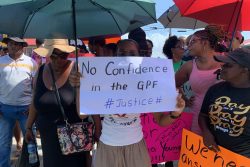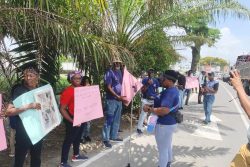 Amid the various discussions of the diverse factors in play, the fundamental piece in mainstream Caribbean tourism is blue water and white sand; traverse the span as I have, from Puerto Rico in the north to tiny Bequia in the south, one will see that, and it is an understandable pull. The water in the Caribbean Sea is a wonder. I spent a good chunk of my life in Grand Cayman, and the sea in that area is as clear as gin. There are no rivers or streams carrying silt to it, and since there is very deep water a quarter of a mile off shore, the ocean currents carry away any foreign material that may arrive on the islands’ doorstep. As a result, the sea all around the three islands (Grand Cayman, Cayman Brac, Little Cayman) is like a swimming pool. The local people fish using a device called a glass box – a small wooden frame with a glass bottom; you rest the box with the glass touching the water and you can see straight to the sea floor 100′ below. The first time you use it, you can’t believe what you’re seeing; it’s like looking into another world, that’s how clear the water is. The local guys will locate fish that way, and drop their bait accordingly. It’s an astonishing thing to see.
Amid the various discussions of the diverse factors in play, the fundamental piece in mainstream Caribbean tourism is blue water and white sand; traverse the span as I have, from Puerto Rico in the north to tiny Bequia in the south, one will see that, and it is an understandable pull. The water in the Caribbean Sea is a wonder. I spent a good chunk of my life in Grand Cayman, and the sea in that area is as clear as gin. There are no rivers or streams carrying silt to it, and since there is very deep water a quarter of a mile off shore, the ocean currents carry away any foreign material that may arrive on the islands’ doorstep. As a result, the sea all around the three islands (Grand Cayman, Cayman Brac, Little Cayman) is like a swimming pool. The local people fish using a device called a glass box – a small wooden frame with a glass bottom; you rest the box with the glass touching the water and you can see straight to the sea floor 100′ below. The first time you use it, you can’t believe what you’re seeing; it’s like looking into another world, that’s how clear the water is. The local guys will locate fish that way, and drop their bait accordingly. It’s an astonishing thing to see.
Furthermore, and what I found even more astonishing, this clear water condition obtains anywhere one goes in these islands. You can take a car in Grand Cayman, the capital, on the western side, drive all the way to East End or to North Side, which is basically a shore-line trip, and at any beach you stop at along the way you will find that same sea-water purity. Ditto with the other two Cayman Islands, and that’s how it is for most of the region; Antigua, St Lucia, St Vincent, Grenada, Barbados, Virgin Islands, Tobago, Anguilla, same story. Warm weather is part of the Caribbean tourism attraction, as are the various carnivals, but carnival is only two or three weeks; those white sand beaches and pristine seas, clear around the year, are the single major tourism pull. During my time there, I recall several tourism agents telling me that, after price, the first question a potential traveller often asks is “How far is it to the beach?” Sea/sand is high up on the Caribbean tourism agenda.
We saw that demonstrated again recently when several Category 5 hurricanes flattened the tourism infrastructure in several islands (Barbuda, Dominica, St Maarten, Puerto Rico). Even a casual look at what happened in the wake of the destruction shows the power of that pull. With the passing of the storms, and with several islands not in a position to host visitors, cruise ships and airlines began diverting passengers, but notice that in each case the alternatives they were choosing were simply other blue-water-white-sand destinations not hammered by the hurricanes in the western Caribbean.
In Grand Cayman, untouched by the storms, what had begun as a season with the normal healthy trade, turned into what merchants reported as the busiest period of the year on the waterfront with shops doing a roaring trade as the town felt the impact of the influx of tourists. The newspaper reported neighbourhood police officers out in force directing traffic and assisting tourists and pedestrians in the town, and that on one Wednesday, a total of 19,722 passengers arrived in port– equivalent to around a third of Cayman’s resident population.
In the aftermath of the storm, cruise ship companies reported that at least 70 ships will be diverted to the Cayman Islands through to the end of April, bringing close to 250,000 extra passengers to the island. The Cayman Compass newspaper told us: “In port one day recently, were the 4,100-passenger Norwegian Epic, the 3,600-passenger Carnival Vista and the 4,400-passenger Liberty of the Seas. Celebrity Reflection brought 3,046 passengers, Marella Discovery II had 2,076 on board, and the Norwegian Pearl brought another 2,500.” That adds up to 6 ships bringing some 20,000 affluent visitors in one day.
The lesson for us there is that with several tourism destinations removed from the travel picture for 2017, companies in the industry did not turn to destinations, such as Guyana, with a more nature-based tourism product. They made a swift business decision to move their customers to destinations offering those same blue-water-white-sand conditions and easily accessible port. Certainly, other factors were in the mix ‒ low crime rate, clean environment, etc ‒ but the fundamental pull of that crystal clear sea made for an almost no-brainer choice.
In the overall, that recent post-hurricane scenario is a stark reminder that Guyana’s tourism planners must keep in mind. As we shape our tourism product, our industry officials seem to be recognising the formidable pull of sea/sand that our Caribbean counterparts have working in their favour and are stressing instead our own formidable nature product. However, if we’re unsure of the level of tourism competition that blue-water-white-sand poses, the recent hurricane consequences point to how strong it is.










